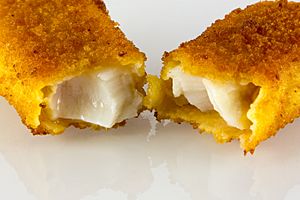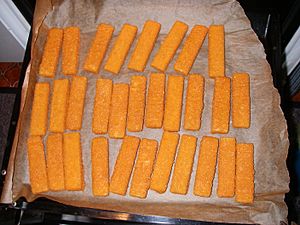Fishstick facts for kids
Fish sticks or fish fingers are a popular food item. They were probably first made in the United Kingdom. Fish sticks are usually made from whitefish like cod. The fish is covered in a special liquid called batter and then coated with breadcrumbs.
People often eat fish sticks with sauces like tartar sauce, cocktail sauce, or ketchup. They are a favorite food for children and their parents because they are easy to cook. They are also a good finger food and can be a healthy meal for kids.
History of Fish Sticks
Fish sticks became possible because of a cool invention in 1929. This was the plate froster, which was the first quick freezer. To freeze food really fast, it needed to be in thin, flat shapes. Fish sticks, which are thin pieces of fish covered in breadcrumbs, were perfect for this new freezing method.
In Britain during the 1950s, a lot of herring fish was caught. Most of it was pickled and sent to other countries in North Europe. Companies wanted to make herring more popular at home. So, they tried making "herring savouries," which were like herring fish sticks.
They also tested plain cod sticks, calling them "fish fingers." People in Southampton and South Wales really loved the cod ones! The first cod fish sticks were made in Great Yarmouth, Britain, and sold starting September 26, 1955. They became super popular after TV commercials started in 1956. Even today, fish sticks are a favorite food for many children.
How Fish Sticks Are Made
On big production lines, fish are first prepared. A machine removes the fillet (the meaty part) from each side of the backbone. Another machine then takes off the skin from the fish flesh. Sometimes, tiny bones are left, so those parts are carefully cut out.
Next, the fish fillets are pressed into frozen blocks. A conveyor belt moves these blocks through batter and then breadcrumbs. This makes the fish stick twice as thick. After that, each fish stick goes through hot vegetable oil for about a minute. This seals the coating and gets them ready for you to grill or fry at home.
Then, the fish sticks are frozen again very quickly. Their center reaches a super cold temperature in less than 20 minutes. After they are packaged, they are stored in even colder freezers. This keeps them fresh and ready to be sent to stores for you to enjoy!
Images for kids
See also
 In Spanish: Palito de pescado para niños
In Spanish: Palito de pescado para niños





